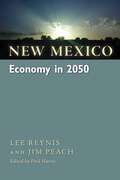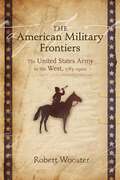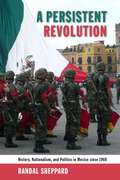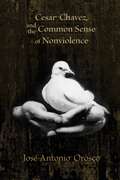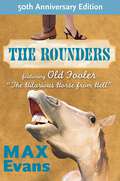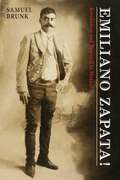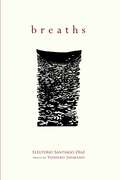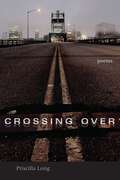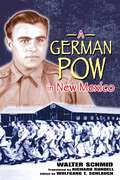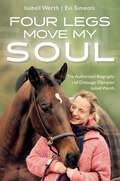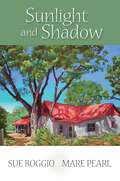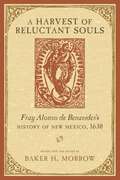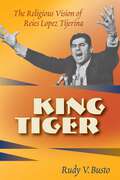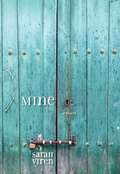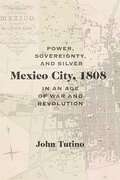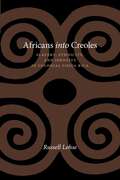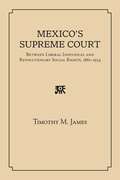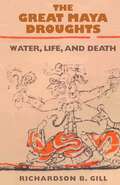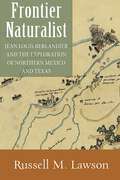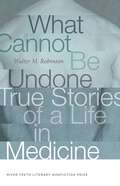- Table View
- List View
New Mexico Economy in 2050
by Lee Reynis Jim PeachIn New Mexico Economy in 2050, an E-short edition from New Mexico 2050, two of the state&’s foremost economists, Lee Reynis of the University of New Mexico and Jim Peach of New Mexico State University, provide an overview of New Mexico&’s economy. Reynis and Peach present the dimensions and effects of income inequality in the region and how it can be ameliorated. This selection also includes two short guest essays, one by Henry Rael on tradition- and culture-based economic development, and the other by Chuck Wellborn on fostering and nurturing homegrown industry.
A Guide to Tongue Tie Surgery: Poems (Mary Burritt Christiansen Poetry Series)
by Tina CarlsonA Guide to Tongue Tie Surgery gives voice to abused children, murdered women, research animals, war veterans, and even metronomes and lampshades. In poems inspired by Ovid, Tina Carlson explores the roots of voicelessness and journeys into metamorphosis, granting speech to those ignored or victimized and thereby allowing them to provide witness to their own lives.
The American Military Frontiers: The United States Army in the West, 1783-1900 (Histories of the American Frontier Series)
by Robert WoosterAs the fledgling nation looked west to the land beyond the Appalachian Mountains, it turned to the army to advance and defend its national interests. Clashing with Spain, Britain, France, Mexico, the Confederacy, and Indians in this pursuit of expansion, the army's failures and successes alternately delayed and hastened western migration. Roads, river improvements, and railroads, often constructed or facilitated by the army, further solidified the nation's presence as it reached the Pacific Ocean and expanded north and south to the borders of Canada and Mexico. Western military experiences thus illustrate the dual role played by the United States Army in insuring national security and fostering national development.Robert Wooster's study examines the fundamental importance of military affairs to social, economic, and political life throughout the borderlands and western frontiers. Integrating the work of other military historians as well as tapping into a broad array of primary materials, Wooster offers a multifaceted narrative that will shape our understanding of the frontier military experience, its relationship with broader concerns of national politics, and its connection to major themes and events in American history.
A Persistent Revolution: History, Nationalism, and Politics in Mexico since 1968
by Randal SheppardSheppard explores Mexico&’s profound political, social, and economic changes through the lens of the persistent political power of Mexican revolutionary nationalism. By examining the major events and transformations in Mexico since 1968, he shows how historical myths such as the Mexican Revolution, Benito Juárez, and Emiliano Zapata as well as Catholic nationalism emerged during historical-commemoration ceremonies, in popular social and anti-neoliberal protest movements, and in debates between commentators, politicians, and intellectuals. Sheppard provides a new understanding of developments in Mexico since 1968 by placing these events in their historical context.The work further contributes to understandings of nationalism more generally by showing how revolutionary nationalism in Mexico functioned during a process of state dismantling rather than state building, and it shows how nationalism could serve as a powerful tool for non-elites to challenge the actions of those in power or to justify new citizenship rights as well as for elites seeking to ensure political stability.
The Last Hanging of Ángel Martinez (Lynn and Lynda Miller Southwest Fiction Series)
by Kate NilesWinner of the 2025 Zia Book Award from New Mexico Press Women 2024 Foreword INDIES Silver Winner for MysteryIn Taos County, New Mexico, probation officer Nina Montgomery thinks she knows all about Ángel Martinez, a “frequent flyer” in the judicial system for increasingly sadistic treatment of his ex-partner, Liza Monaghan. When Liza is found dead on her kitchen floor, everyone suspects Ángel—Nina most of all.When Ángel’s aunt Loretta, Nina’s neighbor and friend, asks her to look into Liza’s murder, Nina reaches out to friend and sheriff’s deputy Larry Baca and becomes embroiled in the case. As Nina delves into Ángel’s and Liza’s lives, she is surprised to learn that Ángel is a santero artist on the rise. A talented but struggling ceramic artist herself, Nina finds her worlds colliding when a Hollywood celebrity wants her art just as the entanglements of Ángel’s family history begin to suggest the source of Liza’s death. Amid the cultural and natural beauty of the Northern Rio Grande Valley, Nina finds herself steeped in the drama of a family gone terribly and violently wrong.
Cesar Chavez and the Common Sense of Nonviolence
by José-Antonio OroscoCesar Chavez has long been heralded for his personal practice of nonviolent resistance in struggles against social, racial, and labor injustices. However, the works of Gandhi and Martin Luther King Jr. have long overshadowed Chavez's contributions to the theory of nonviolence. José-Antonio Orosco seeks to elevate Chavez as an original thinker, providing an analysis of what Chavez called the common sense of nonviolence. By engaging Chavez in dialogue with a variety of political theorists and philosophers, Orosco demonstrates how Chavez developed distinct ideas about nonviolent theory that are timely for dealing with today's social and political issues, including racism, sexism, immigration, globalization, and political violence.
The Rounders
by Max EvansThe bawdy and moving story of two contemporary bronco busters, The Rounders, originally published in 1960, was Max Evans's first novel and is still his best known work, thanks largely to the success of the 1965 movie version starring Henry Fonda and Glenn Ford. Acclaimed for its realistic depiction of modern cowboying and for its humor, it is also a very serious work, described by the author as a tragicomedy.It is a book to read if you are in need of a good laugh or if you are tired of reading cowboy novels where there are no cows and where the cowhands never stop waiting around the local saloon for a final showdown with the visiting Indians.--San Francisco ChronicleOne of the funniest cowpoke yarns to come off the presses in many a fall roundup.--Denver Post
Emiliano Zapata!: Revolution and Betrayal in Mexico
by Samuel BrunkThe life of Mexican Revolutionary Emiliano Zapata was the stuff that legends are made of. Born and raised in a tiny village in the small south-central state of Morelos, he led an uprising in 1911--one strand of the larger Mexican Revolution--against the regime of long-time president Porfirio Díaz. He fought not to fulfill personal ambitions, but for the campesinos of Morelos, whose rights were being systematically ignored in Don Porfirio's courts. Expanding haciendas had been appropriating land and water for centuries in the state, but as the twentieth century began things were becoming desperate. It was not long before Díaz fell. But Zapata then discovered that other national leaders--Francisco Madero, Victoriano Huerta, and Venustiano Carranza--would not put things right, and so he fought them too. He fought for nearly a decade until, in 1919, he was gunned down in an ambush at the hacienda Chinameca. In this new political biography of Zapata, Brunk, noted journalist and scholar, shows us Zapata the leader as opposed to Zapata the archetypal peasant revolutionary. In previous writings on Zapata, the movement is covered and Zapata the man gets lost in the shuffle. Brunk clearly demonstrates that Zapata's choices and actions did indeed have an historical impact.
Breaths (Mary Burritt Christiansen Poetry Series)
by Eleuterio Santiago-DíazBreaths is a poetic exploration of Budo (the Japanese martial arts) and Zen. It delves into the relationship between these two traditions and projects their spirit onto the textures of everyday life. The poems balance action, energy, meditation, and contemplation on how to live attentively and actively in the world. Accompanied by Yoshiko Shimano&’s eloquent prints, these poems will energize and captivate readers while inviting them to seek their own paths to illumination.
Crossing Over: Poems (Mary Burritt Christiansen Poetry Series)
by Priscilla LongLong&’s work begs to be read aloud in order to savor the rich language and rhythm she instills in each poem. She explores the beauty of specific bridges while employing them as a metaphor for crossings to death (a sister&’s suicide), eros, and art. Part elegy, the book also explores living, remembering, and celebrating.
A German POW in New Mexico (Historical Society of New Mexico Publication Series)
by Walter SchmidWalter Schmid, a member of Rommel's Afrika Korps, was one of hundreds of thousands of POWs interned in the United States during World War II. Drafted into the German army at twenty, he had fought for only five months when captured in Tunisia in May 1943. Schmid was sent first to POW camps in Oklahoma (Gruber, Bixby, and McAlester) and was soon transferred to New Mexico in July 1944.Walter Schmid worked in southern New Mexico's Mesilla Valley picking cotton and harvesting melons alongside Mexican-American laborers. He recalls playing trumpet in the camp orchestra and watching Sunday soccer games between the teams of rival POW camps. Based on his diary and the letters he sent home to his German girlfriend, whom he later married, Schmid's memoir was published in Germany in 2000. This abbreviated English translation begins with his capture in North Africa and his voyage to the United States and ends with his work experience in England, where he was transferred after almost three years of captivity in the United States, and his return to Germany in 1947.
Finding Your Superhorse
by Lynn PalmLessons on how to tap the true potential in every horse from one of the world's leading female trainers.For six decades, Lynn Palm has been a mainstay of the horse training, showing, and clinicing industry. Her successes in diversity in training and the development of willingness and ability across disciplines are unparalleled. She has four Superhorse Titles—a prize awarded to a horse that demonstrates a broad skillset and proficiency in multiple sports. In these pages, Lynn shares the eight keys to her success in training and competing, and how you, too—whether you're eventing or ranch riding—can shape a horse with a good attitude, correct movement, healthy biomechanics, and top-notch conditioning. A &“Superhorse&” will take you farther for longer, and you'll enjoy every minute of it.Readers will learn how:Not all knowledge is good knowledge, and which knowledge is best.Groundwork in the form of in-hand, longeing, liberty work, long-lining, and trick training is integral to attaining training goalsTo incorporate longevity training with progressive lessons that have the &“long game&” in mindThe rider's ability directly impacts the horse'sA competitive edge serves both the recreational rider and the one who showsTo overcome the inevitable challenges when training a horse and facing questions of persistence versus suitabilityWe need to do better for the horse in equestrian sport&“Giving back&” to the industry provides a foundation for Superhorses for generations to comeWith a rich mix of stories curated from years of horse adventures, practical ideas you can put to work in your own arena, and exercises to incorporate in your daily practice,Finding Your Superhorseis the rare inspiring read that teaches. Throughout, Lynn's warmth of character and intense commitment to horses, horse people, and improving the industry that has given her a life and a livelihood shine through, guiding us all toward what's possible and the &“super&” in every horse.
Four Legs Move My Soul
by Isabell WerthGerman Olympian Isabell Werth is one of the most successful horsewomen in the world. With six Olympic gold medals and scores of championship titles to her name, there are few her equal on paper. But an equestrian&’s success is wholly dependent on the relationship she has with her athletic partner—her horse—and Werth&’s astounding accomplishments would not have been possible without her unique approach to working with the animals she&’s loved since childhood. Even as a little girl, growing up on a farm on the Lower Rhine, it was clear that Werth possessed an extraordinary gift for empathizing with horses and foreseeing how they were likely to react in certain situations. This insight gave her a special ability as a rider and trainer. Here, Werth collaborates with accomplished sports journalist Evi Simeoni—someone who has witnessed and written about her career from the very beginning—to tell her life story. Readers will get the inside scoop when it comes to Werth&’s accomplishments—and her failures, too. They&’ll hear her personal thoughts regarding some of the biggest controversies to rock the dressage world: Rollkur and Totilas. Perhaps most importantly, they&’ll learn about each of the sensitive and talented horses that has impacted Werth&’s life, including Gigolo, Satchmo, and Bella Rose. For you see, there is a meme that is popular in the riding community that says, &“Two legs move our body, four legs move our soul.&” And it is this sentiment that Werth feels perhaps best defines her.
Sunlight and Shadow
by Sue Boggio Mare PearlAn acclaimed first novel by two award-winning New Mexico writers, Sunlight and Shadow is a story of family, friendship, and what it really means to have hope.&“Everything is going well for San Diego restaurateur Abby Silva. She is four months pregnant, and her husband Bobby is finished with his last tour as a Navy submariner, but their happiness is interrupted by a brutal robbery, followed by Bobby's father's sudden death. Bobby and Abby's mixed marriage angered their families. Her wealthy white parents disowned her after she married a Hispanic, and Bobby's father felt that his son was denying his heritage. Now Bobby wants Abby to have the baby in the tiny New Mexico town of Esperanza where he grew up so she can experience the feeling of 'La Familia,' where everyone helps one another. Abby reluctantly agrees, then Bobby mysteriously disappears. The neighbors gather around to help, and new entanglements ensue in this wonderful first novel by two talented authors who vividly bring to life the beauty of New Mexico and its people.&”—Booklist&“Sue Boggio and Mare Pearl are vivid and sensual writers. From raising goats to making tortillas, life on a farm in Esperanza is beautifully described. Sunlight and Shadow captures the complexities of rural life in New Mexico and presents an intriguing mix of Anglo and Hispanic characters. The plot is fascinating and the characters are well developed. It's a wonderful book.&”—Judith Van Gieson&“Filled with emotion. A real winner of a story.&”—Tony Hillerman
A Harvest of Reluctant Souls: Fray Alonso de Benavides's History of New Mexico, 1630
by Baker H. MorrowThe most thorough account ever written of southwestern life in the early seventeenth century, this engaging book was first published in 1630 as an official report to the king of Spain by Fray Alonso de Benavides, a Portuguese Franciscan who was the third head of the mission churches of New Mexico. In 1625, Father Benavides and his party traveled north from Mexico City to New Mexico, a strange land of frozen rivers, Indian citadels, and mines full of silver and garnets. Benavides and his Franciscan brothers built schools, erected churches, engineered peace treaties, and were said to perform miracles.Benavides&’s riveting exploration narrative provides portraits of the Pueblo Indians, the Apaches, and the Navajos at a time of fundamental change. It also gives us the first full picture of European colonial life in the southern Rockies, the southwestern deserts, and the Great Plains, along with an account of mission architecture and mission life and a unique evocation of faith in the wilderness.
King Tiger: The Religious Vision of Reies Lípez Tijerina
by Rudy V. BustoRight now we look like a cricket. What is a cricket? King of the Insects; a little, tiny animal. All the cricket can do is [say] 'cricket, cricket, cricket.' Just a noise, that's all. But you know, if that cricket gets in the ear of the lion and scratches inside, there is nothing the lion can do. There is nothing; there is no way the lion can use his claws and jaws to destroy the cricket. The more the lion scratches himself the deeper the cricket goes. . . .--Reies López Tijerina, 1971Throughout his career in New Mexican land grant politics, Reies Tijerina frequently used this fable to inspire persistence in the face of impossible odds. As the leader of a grassroots Hispano land rights organization, the Alianza Federal de Mercedes Reales (The Federal Alliance of Land Grants), Tijerina has made an indelible imprint on New Mexico's Hispano culture. King Tiger details Tijerina's life and efforts--those real, rumored, and mythologized--in the first systematic study of the origin of his political ideas. Rudy Busto shows how one of Tijerina's particularly powerful mystical visions led him to northern New Mexico to fight to restore land to those who lost it during various nineteenth-century land grant title conflicts. More than three decades after the infamous Tierra Amarilla County courthouse raid, Tijerina remains an important touchstone for all New Mexicans. In his life and activism are found the interdependent issues of land, water, language, economic development, sovereignty, political power, and rights to cultural formation in the Southwest.
MINE: Essays (River Teeth Literary Nonfiction Prize Series)
by Sarah VirenThis is a book about ownership. It begins with an essay about being given a man&’s furniture while he&’s on trial for murder and follows with essays that question corporeal, familial, and intellectual forms of ownership. What does it mean to believe that a hand, or a child, or a country, or a story belongs to you? What happens if you realize you&’re wrong? Mining her own life and those of others, Sarah Viren considers the contingencies of ownership alongside the realities of loss in this debut essay collection.
Mexico City, 1808: Power, Sovereignty, and Silver in an Age of War and Revolution (Diálogos Series)
by John TutinoIn 1800 Mexico City was the largest, richest, most powerful city in the Americas, its vibrant silver economy an engine of world trade. Then Napoleon invaded Spain in 1808, desperate to gain New Spain&’s silver. He broke Spain&’s monarchy, setting off a summer of ferment in Mexico City. People took to the streets, dreaming of an absent king, seeking popular sovereignty, and imagining that the wealth of silver should serve New Spain and its people—until a military coup closed public debate. Political ferment continued while drought and famine stalked the land. Together they fueled the political and popular risings that exploded north of the capital in 1810.Tutino offers a new vision of the political violence and social conflicts that led to the fall of silver capitalism and Mexican independence in 1821. People demanding rights faced military defenders of power and privilege—the legacy of 1808 that shaped Mexican history.
Africans into Creoles: Slavery, Ethnicity, and Identity in Colonial Costa Rica (Diálogos Series)
by Russell LohseUnlike most books on slavery in the Americas, this social history of Africans and their enslaved descendants in colonial Costa Rica recounts the journey of specific people from West Africa to the New World. Tracing the experiences of Africans on two Danish slave ships that arrived in Costa Rica in 1710, the Christianus Quintus and Fredericus Quartus, the author examines slavery in Costa Rica from 1600 to 1750. Lohse looks at the ethnic origins of the Africans and narrates their capture and transport to the coast, their embarkation and passage, and finally their acculturation to slavery and their lives as slaves in Costa Rica. Following the experiences of girls and boys, women and men, he shows how the conditions of slavery in a unique local setting determined the constraints that slaves faced and how they responded to their condition.
Yoruba Traditions and African American Religious Nationalism (Religions of the Americas Series)
by Tracey E. HucksExploring the Yoruba tradition in the United States, Hucks begins with the story of Nana Oseijeman Adefunmi&’s personal search for identity and meaning as a young man in Detroit in the 1930s and 1940s. She traces his development as an artist, religious leader, and founder of several African-influenced religio-cultural projects in Harlem and later in the South. Adefunmi was part of a generation of young migrants attracted to the bohemian lifestyle of New York City and the black nationalist fervor of Harlem. Cofounding Shango Temple in 1959, Yoruba Temple in 1960, and Oyotunji African Village in 1970, Adefunmi and other African Americans in that period renamed themselves &“Yorubas&” and engaged in the task of transforming Cuban Santer'a into a new religious expression that satisfied their racial and nationalist leanings and eventually helped to place African Americans on a global religious schema alongside other Yoruba practitioners in Africa and the diaspora.Alongside the story of Adefunmi, Hucks weaves historical and sociological analyses of the relationship between black cultural nationalism and reinterpretations of the meaning of Africa from within the African American community.
Mexico's Supreme Court: Between Liberal Individual and Revolutionary Social Rights, 1867-1934
by Timothy M. JamesAlthough Mexico&’s Constitution of 1917 mandated the division of large landholdings, provided land for the landless, and guaranteed workers the rights to organize, strike, and bargain collectively, it also guaranteed fundamental liberal rights to property and due process that enabled property owners and employers to resist the implementation of the new social rights by filing suit in federal court. Taking as its main focus the way new and old rights were adjudicated before the Supreme Court, this book is the first to examine the subject through the lens of court documents and the writings and commentaries of jurists and other legal professionals. The author asks and answers the question, how did the judicial interpretation of the Constitution of 1917 become a barrier to implementing agrarian land rights and labor legislation in the years immediately following Mexico&’s social revolution of 1910?
The Great Maya Droughts: Water, Life, and Death
by Richardson B. GillThis innovative study argues that the collapse of Classic Maya civilization was driven by catastrophic drought. Between A.D. 800 and 1000, unrelenting drought killed millions of Maya people with famine and thirst and initiated a cascade of internal collapses that destroyed their civilization. Linking global, regional, and local climate change, the author explores how atmospheric processes, volcanism, ocean currents, and other natural forces combined to create the dry climate that pried apart the highly complex civilization in the tropical Maya Lowlands in the ninth and tenth centuries.Drawing on knowledge of other prehistoric and historic droughts, The Great Maya Droughts is a useful study of the relationship of humans to their natural and physical environment. The author tries to understand why the Classic Maya failed to adjust their behavior and culture to the climatic conditions and why civilizations in general sometimes collapse in the face of radical environmental change.
Frontier Naturalist: Jean Louis Berlandier and the Exploration of Northern Mexico and Texas
by Russell M. LawsonThis is a true story of discovery and discoverers in what was the northern frontier region of Mexico in the years before the Mexican War. In 1826, when the story begins, the region was claimed by both Mexico and the United States. Neither country knew much about the lands crossed by such rivers as the Guadalupe, Brazos, Nueces, Trinity, and Rio Grande. Jean Louis Berlandier, a French naturalist, was part of a team sent out by the Mexican Boundary Commission to explore the area. His role was to collect specimens of flora and fauna and to record detailed observations of the landscapes and peoples through which the exploring party traveled. His observations, including sketches and paintings of plants, landmarks, and American Indians, were the first compendium of scientific observations of the region to be collected and eventually published.Here, historian Russell Lawson tells the story of this multinational expedition, using Berlandier&’s copious records as a way of conveying his view of the natural environment. Lawson&’s narrative allows us to peer over Berlandier&’s shoulder as he traveled and recorded his experiences. Berlandier and Lawson show us an America that no longer exists.
Getting in TTouch with Your Dog
by Linda Tellington-JonesThe international bestseller from acclaimed animal expert and companion animal trainer Linda Tellington-Jones.Hands-on help from one of the most caring and innovative animal trainers in the world! Linda Tellington-Jones offers her acclaimed form of gentle bodywork and behavior training, giving you tools to:• Influence your dog&’s behavior and performance while enhancing your relationship.• Reduce stress, overcome anxiety, and increase focus.• Assist in recovery from injury or illness.• Relieve discomfort in cases of aging, arthritis, and hip dysplasia.• Solve behavior problems, such as leash pulling, excessive barking, and fear of thunder.• Teach your dog to have his mouth handled and his toenails clipped.Tellington-Jones provides the ultimate reference for safe, gentle, idealistic care for and training of dogs, all ages, breeds, and sizes. Her methods are the key to a better quality of life for your dog.
What Cannot Be Undone: True Stories of a Life in Medicine (River Teeth Literary Nonfiction Prize Series)
by Walter M. RobinsonIn his award-winning debut essay collection, What Cannot Be Undone, Walter M. Robinson shares surprising stories of illness and medicine that do not sacrifice hard truth for easy dramatics. These true stories are filled with details of difficult days and nights in the world of high-tech medical care, and they show the ongoing struggle in making critical decisions with no good answer. This collection presents the raw moments where his expertise in medical ethics and pediatrics are put to the test. He is neither saint, nor hero, nor wizard. Robinson admits that on his best days he was merely ordinary. Yet in writing down the authentic stories of his patients, Robinson discovers what led him to the practice of medicine—and how his idealism was no match for the realities he faced in modern health care.
